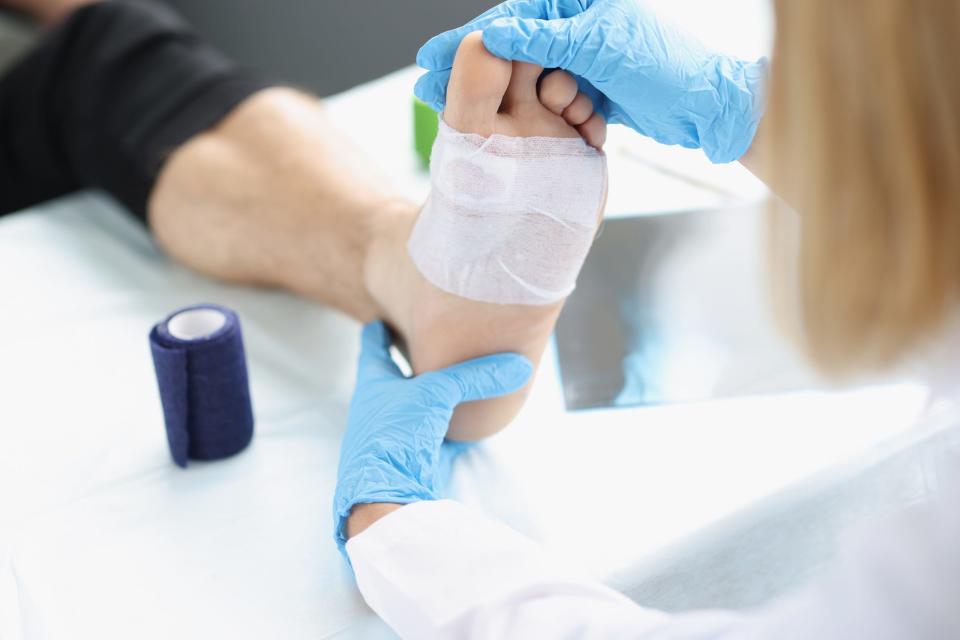Ask the Expert: Advanced wound care treatment boosts ability to heal
MUNCIE, Ind. – Millions of people are living with chronic wounds in the United States and the numbers are growing.
Chronic wounds are more prevalent among the 30.3 million Americans diagnosed with diabetes, who have a 25 percent risk of developing a foot ulcer. Increased age, obesity, heart and vascular disease, cancer treatment and traumatic injury may also contribute to non-healing wounds.
Why do non-healing wounds require specialized care?
Non-healing wounds like diabetic foot ulcers, arterial or ischemic ulcers, venous or stasis ulcers, and pressure ulcers, require specialized care because underlying, complex conditions prevent the wound from going through the expected healing stages. The longer a chronic wound goes untreated, the greater your risk of infection, amputation, and other complications. A chronic wound can detract from your quality of life and prevent you from doing things you enjoy.

What causes non-healing wounds?
Non-healing wounds can be caused by:
Deep underlying infection
Diabetes or other underlying medical conditions
Environmental factors, such as exposure to secondhand smoke
Immobility, which causes pressure sores, also known as bed sores
Poor blood flow
Poor nutrition
Repeated trauma from improper management of the wound, including use of toxic solutions or traumatic dressing application and removal
What treatment options are available for wound care?
Managing wounds, whether short-term or chronic, can be a major challenge. Treatment plans are never one size fits all. At IU Health Ball Wound Healing Services, your individualized treatment plan may include:
Compression
Compression bandaging therapy is used to reduce swelling, particularly in arms and legs, with specialized bandaging. We offer many kinds of compression therapies, including compression bandaging and compression pumps. We work with outpatient Lymphedema Clinic for lymphedema management after wounds are healed to prevent recurrence.
Negative pressure wound therapy
Negative pressure wound therapy promotes healing using a gentle vacuum pump. The vacuum draws increased blood flow to the area and stimulates cells to promote new tissue growth, allowing the wound to heal quicker. Negative pressure wound therapy allows you to heal from the comfort of your own home with support from our highly-skilled home care team.
Benefits of negative pressure wound therapy:
Reduces hospital length of stay
Accelerates wound healing
Promotes new tissue growth
Reduces infection rates
Custom total contact casting
Total contact casting is considered the gold standard of treatment if you have wounds on the bottom of your feet due to diabetes. A cast customized to your foot transfers the weight of your body away from the wound itself when you stand or walk. (This treatment may not be available at all hospital locations).
Sharp selective debridement
This is the removal of tissue that is no longer healthy from the surface of a wound. This helps prevent infection and allow new healthy tissue to grow in its place.
Skin substitutes and/or skin grafts
Skin substitutes and/or skin grafts are biologic or synthetic materials that provide temporary or permanent coverage of open skin wounds.
Hyperbaric oxygen therapy
Hyperbaric oxygen therapy (HBO therapy) is used to treat non-healing wounds. HBO therapy delivers 100% pure oxygen under increased atmospheric pressure in a clear acrylic, mono-place chamber.
Benefits of hyperbaric oxygen therapy:
Accelerates the wound healing process
Increases oxygenation to all tissues
Promotes collagen and new skin development
Reduces swelling and discomfort
Promotes new blood vessel formation
Increases capillary growth
Activates bactericidal activity killing bacteria
Other therapies for wound care
In addition to medical treatment and care of the wound itself, you may also be referred to physical and or occupational therapy to address functional difficulties you may have with activities of daily living associated with the wound.
Summer Bertram, BSN, RN, CWOCN, is the program director for the IU Health Ball Wound Healing Center. Learn more at https://iuhealth.org/find-medical-services/wound-care.
This article originally appeared on Muncie Star Press: Ask the Expert: Seek special treatment for wounds that won't heal

